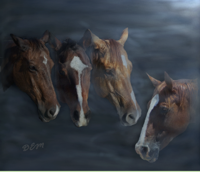
Reins
[As additional resources, links to book reviews and book purchasing information can be found beneath the quotations when this information is available.]
"As the snaffle is higher in the mouth than the curb, its principal action is to raise the head of the horse, and that of the curb to lower it....therefore, the reins should occupy the same respective positions in the hand, as the snaffle and curb do in the mouth namely, the snaffle reins should be above the curb reins."
James Fillis, Breaking and Riding
Buy Book
(Top)
"The rider should never try to force the contact by pulling at the reins, which would restrict the horse's urge to go forward."
Alois Podhajsky, The Riding Teacher
Buy Book
(Top)
"When it comes to pressure on those reins, why we'd like the horse to respond before the slack is taken out."
Bill Dorrance and Leslie Desmond, True Horsemanship Through Feel
Read Review
Buy Book
(Top)
"It really bothers a horse when someone keeps steady pressure on his mouth when he's just standing there, or when he's willing and moving faster, too."
Bill Dorrance and Leslie Desmond, True Horsemanship Through Feel
Read Review
Buy Book
(Top)
"When a fella's in the habit of hanging heavy on the horse's mouth, he's liable to just pull on those reins a little harder when he wants that horse to liven up and go some place."
Bill Dorrance and Leslie Desmond, True Horsemanship Through Feel
Read Review
Buy Book
(Top)
"Are not the loose reins a symbol of willingness, a symbol of partnership, trust, and harmonious friendship?"
Klaus Ferdinand Hempfling, Dancing with Horses
Read Review
Buy Book
(Top)
"Uwittingly, new and modern ideas have allowed riders to become far more dependent on the reins than ever before. Thus ideas concerning the importance of teaching an effective controlling seat have diminished drastically with the disappearance of one-handed riding."
Sylvia Loch, The Classical Rider
Read Review
Buy Book
(Top)
"For some, it is no longer enough to ride with two or four reins in two hands, they have to resort to draw reins, balancing reins and all forms of constricting nosebands to obtain, again from the front, the control they lack from the seat."
Sylvia Loch, The Classical Rider
Read Review
Buy Book
(Top)
"For a long time now I have spoken out against the use of draw reins and balancing reins as, invariable, they are used on immature or unmuscled horses who are simply not ready to be shaped in this way. Worse, they are generally made to be worn for much too long at a time and through quite rigorous exercise which will cause real pain. The argument that they are safe in the hands of experts makes one wonder just how good these experts are if they need to resort to artificial aids of such an unyielding nature."
Sylvia Loch, The Classical Rider
Read Review
Buy Book
(Top)
"...a different length of rein, the horse's head being higher or lower, or the horse looking one way instead of the other are just a few factors that could change how the horse experiences the bit even if the rider's hand movement is exactly the same."
Kathleen Schmitt, The Seamless Seat
Read Review
Buy Book
(Top)
"...securing the reins between your thumb and forefinger leaves your fingers relaxed and free to move. This allows a smoother, softer, more responsive touch on the reins than when your fingers are busy holding the reins."
Kathleen Schmitt, The Seamless Seat
Read Review
Buy Book
(Top)
"Sensitive hands attached to an unbalanced rider cannot avoid making mistakes with the reins."
Kathleen Schmitt, The Seamless Seat
Read Review
Buy Book
(Top)
"The horse would experience the passive rein as the bit staying still in its mouth, regardless of where its mouth is. The rider would experience the passive rein as a consistent feel in their hand(s) regardless of where the horse's head is or where their hands are."
Kathleen Schmitt, The Seamless Seat
Read Review
Buy Book
(Top)
"The passive rein says nothing about how much weight 'should' be in the reins, just that it would be consistent."
Kathleen Schmitt, The Seamless Seat
Read Review
Buy Book
(Top)
"...passive rein aids provide you and your horse comfort, diagnostics, and clarity of communication."
Kathleen Schmitt, The Seamless Seat
Read Review
Buy Book
(Top)
"Our hands may well move with the horse's motion even as we accept some of the weight/pressure the horse allows into the reins."
Kathleen Schmitt, The Seamless Seat
Read Review
Buy Book
(Top)
"If you are riding with very long reins, you may have to bring your hand(s) back enough for the horse's motion to reach the bit before an active rein aid can really begin. However, horses do respond simply to changes in how loose reins(s) are, so a noticeable hand movement may not prove necessary even with long reins. Horses are well aware of less slack in the rein and respond accordingly."
Kathleen Schmitt, The Seamless Seat
Read Review
Buy Book
(Top)
"A horse cannot easily tug very hard on just one rein."
Kathleen Schmitt, The Seamless Seat
Read Review
Buy Book
(Top)
"A horse can't lug on something that isn't rigid."
Kathleen Schmitt, The Seamless Seat
Read Review
Buy Book
(Top)
"...the true reined horse was worked on contact, going on a truly loose rein only from here to there."
Mary Twelveponies, Everyday Training: Backyard Dressage
Read Review
Buy Book
(Top)
"The fully trained horse — both dressage and reined — leaves a slight droop in the reins when working balanced and on contact."
Mary Twelveponies, Everyday Training: Backyard Dressage
Read Review
Buy Book
(Top)
(Top)